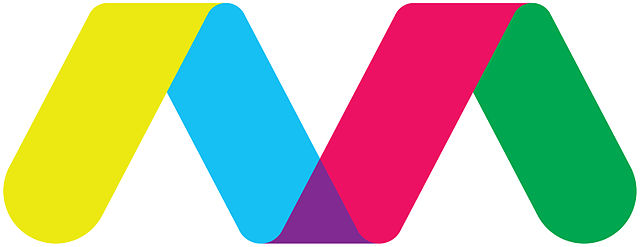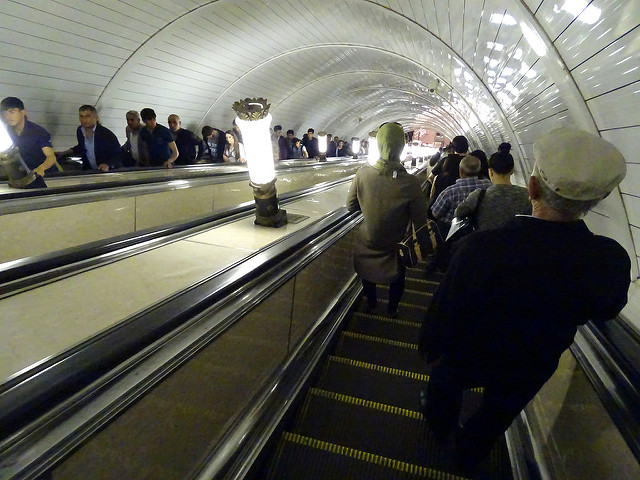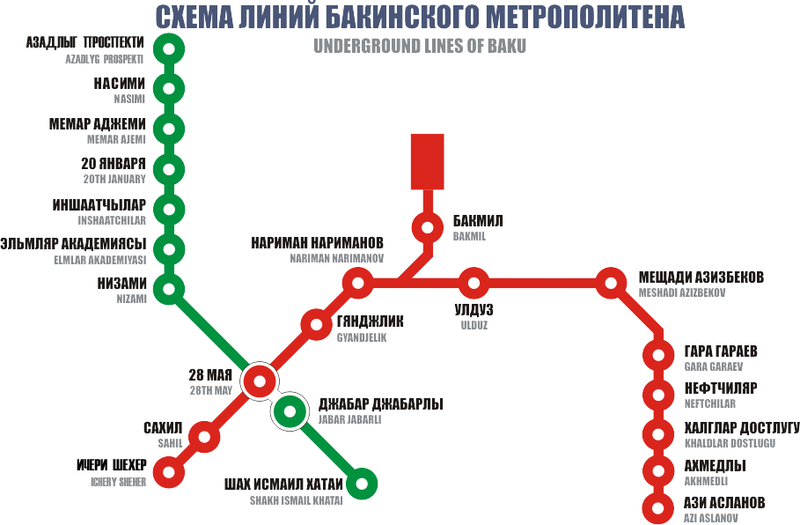The subway of Baku is a public underground railway transport system located in the city of Baku, the capital of Azerbaijan and in the Azeri language it is known as BakiMetropoliteni. Currently, the system has three operating lines with a total of 25 stations and a total length of 36.63 kilometres. The subway was inaugurated in 1967 during the Soviet domination of the country and therefore, it still preserves the Soviet architectural style of the subways that were built at that time. Also, it is the only subway system in the country.
Its corporate image is an M and it has 4 lines in different colours; yellow, cyan, fuchsia and green. The basic fee to enter the metro system is 20 qapik or cents of mana (US $ 0.12) and it operates from 6:00 in the morning to midnight.
The Azerbaijan Subway System: Baku
Baku is the capital of the Republic of Azerbaijan, a country that gained its independence from the Soviet Union in 1990. The city is located in the Absheron Peninsula on the shores of the Caspian Sea.
Azerbaijan, together with Georgia and Armenia, is a country of the Caucasus Region and Baku is the most populated city with more than two million inhabitants. Although, geographically, it is an Asian city, historically it is more linked to the European continent.
The city is divided in eleven districts and 48 municipalities. The division between the Old City and its urban centre is more significant, and it has been declared UNESCO World Heritage Site, as well as the Maiden Tower and the Shirvanshah Palace.
Under Soviet rule, Baku was the oil hub of the USSR, but today it specializes more in the scientific and research fields. The economy of the city is strongly influenced by the harbour presence since the International Maritime Trade Port of Baku is located in front of the Baku archipelago.
The city is located in a semi-arid climate. However, summers are not very hot with an average temperature of 26° C and 4 ° C in the winter months.
The Baku Subway, or BakiMetropolitani, by its Azerbaijani name, is one of the most important rail transport systems in the region and the first of an Islamic country. The rail system was inaugurated in 1967 and it currently has 25 stations grouped into three subway lines and 36.63 kilometres length.
The Russian company Metrowagonmash has historically been responsible for providing trains to the subway system. In 2005, there were 43 trains with five wagons each, but they were old models. Hence, in 2014 the trains were renewed by new 81-760 / 761 models, which were developed in consortium withMetrowagonmash and the French Alstom.

A total number of 222 million passengers used the Baku subway in 2015, with a daily average of approximately 608.2 passengers. The System is operated by a public and a private entity called Baku Metro Closed Joint-Stock Company.
- Metro name: BakiMetropolitani
- Length: 36.63 kilometres
- Track width: 1435 mm
- Number of lines: 3
- Number of stations: 25
- Website: www.metro.gov.az
- Operator: Baku Metro Closed Joint-Stock Company
- Daily passengers: 608,200, approximately.
- Foundation: November 6, 1967
Brief history
The Baku Subway is a project of utmost importance for the Caucasus region. During the Soviet Union industrialization, the large urban poles began to develop and this led to the creation of several subway systems, such as the one in Moscow and Leningrad.
The Baku Subway project began in the 1930's, but was suspended due to the breaking out of WW II. The construction of the metro would begin again in 1953, but it would stop shortly. It was not until 1960 that the construction of the first 12.4 km of the system, were resumed. Finally, the first five stations of the red line of the Baku Subway would be inaugurated on November 6, 1967.
The System has continued to expand since then. The red line was completed in three stages, and simultaneously the green line, next to the river, was constructed. Then, the political situation in Azerbaijan became turbulent, due to it becoming independent from the URSS and coming into conflict with Armenia during the Nagorno-Karabakh War. In effect, the inauguration of the stations was suspended until the end of the 90s and the beginning of the new millennium. Finally, the construction of the northern part of the green line was completed, and more recently, in 2016 the two stations of the purple line were inaugurated.
Lines and stations
The BakuMetropolitani has three lines with 25 stations in total, covering a distance of kilometres. The city of Baku has a rather complicated geology, which lead to the exploration of different construction methods. As a result, four stations are superficial, but the majority are underground. Many of the underground ones are very deep, while a few of them have less depth and a total of 18 stations have escalators and only two have an elevator. The lines that form the Baku Metro system are:
Red line
It is the first line of the Baku Metro and was inaugurated along with the opening of the system on November 6, 1957 with only five stations. Currently, the line has 13 stations, with a total of 18.80 kilometres, making it the longest metro line. The last stations of this route are Icherisheher and HaziAslanov and one of these stations is located in the Old City of Baku.
Green Line
In 1968 the first two stations of the second line of the Baku Metro were inaugurated and assigned the green colour. At first, its route was only 2.2 kilometres and two stations, but now it is 15.54 kilometres and has ten stations. The last stations of the line are Khatai and Darnagul.
Purple Line
The purple line's inauguration took place on April 19, 2016 and was an important milestone in the history of the Baku Metro since it took many years to be built. Back then, the line was 2.07 kilometres long and had only two stations called Avtovagzal and MemarAjami, with a length of 2.07 kilometres. Currently, there are three more stations under construction.
Connections with other systems.
Although the primary mean of transportation in the city of Baku is the subway, it will never be enough. Therefore, the development of other public transport systems essential. Despite the great popularity of the Baku Metro, buses continue to provide transportation to a large part of the city. Unfortunately, this system does not yet have full integration with the Baku Subway, but there is already a card that is compatible with both systems. The rate is the same for the subway and the bus (.20qapik or $0.12USD) within the city, but it might increase to 30 (0.17 US $) or 50 qapik (0.29 US $) when going to suburban and extra- urban areas. The largest bus terminal in the city is Avtovaghzal, and from there you can take buses to Georgia or Russia.
In the urban part of the city there is also the Baku Funicular. This transport system was inaugurated in 1960 and connects the stations of Bahram Gur and Martyrs' Lane. Currently, the funicular is more modern than at the time of its foundation and its nearest subway station is Icherishehe , in the red line.
Azerbaijan has another important railway transport system, which in Azeri is called AzərbaycanDəmirYolları, but which in English is Azerbaijan Railways and it is one of the heirs of Soviet Railways. Baku has a very important central train station, which is the largest in the country. It connects with the Hinterland and a railroad that will connect it with Georgia and Turkey is now being constructed. Although, many trains can be taken to nearby cities in the Baku area, to get to this station you have to get off at station 28 May of the red line.
Also, in the long distance routes there is the lacustrine transport. Since Baku is a port city because it borders the Caspian Sea, the largest in the world, there are constant ferries going to other countries from nearby harbours, especially to Turkmenistan.
 Image via Adam Jones
Image via Adam Jones
Connections with the airport
The city of Baku is communicated by the Baku Heydar Aliyev International Airport. It is the most important airport in Azerbaijan and in the entire Caucasus region, and it is the sixth international airport in the country. It is located approximately 20 kilometres northwest of the city. Although, It still has no connection with the Baku Subway, a new station for the airport service will be constructed in the expansion plans of the subway system.
To get from the Heydar Aliyev Airport to the Baku Subway it is necessary to take a bus. In order to reach the city from the airport there is the Airport Express bus line 16, which leaves every 30 minutes from Terminal 1 The nearest subway station is SamadVurgun Garden close to the May 28 station of the red line. Also, on the route, you pass through the Koroğlu station of the red line and the cost of the ticket is 0.30 Azeri manat (0.17 US $).
Schedule and frequency
The Baku Metro has a fixed timetable. It opens every day at six in the morning and closes at midnight. However, the frequency of trains varies depending on the route.
The trains of the red line depart from Bakmil central station, which is located at an intersection of the line, and transfer with the green at 6:06 in the morning on weekdays. The last one leaves this station at 12:05 AM. On the other hand, on weekends and holidays, the first train departs from this station at 6:01 in the morning and the last departs at 11:09 in the night. The frequency on regular days varies, being every three to six minutes in rush hours or up to ten minutes in less busy schedules.
Around 10 in the morning, the waiting time could be up to an hour. However, the subways frequency increases at the end of the afternoon.
The first train of the green line departs from Darnagul, its last station, at 6:32 in the morning and the last one leaves at 11:53 in the night during weekdays. On weekends and holidays, the first train departs at 7:06 in the morning, while the last train leaves at 12:14 in the night. The frequency also varies depending on the time of the day, but in the early hours it is between half an hour and 45 minutes. Later during the day, the waiting time is around an hour and 30mins during rush hours.
Rates, tickets and cards
From August 8, 2015, the ticket prices of the Baku Metro were unified, replacing the old cards with the modern BakiKart card. One-way ticket price is 0.20 Azeri manat (0.12 US $), regardless of the distance and these cards unify the metro and busticket prices, since they can also be used on the buses that belong to BakuBus.
There are two possibilities to buy the BakiKart. The first option is for those users who wish to buy a BakiKart for unlimited trips for 45 days, which can be purchased in the ticket machines available at the metro stations and the card cost is 2 mana (1.16 US$). A BakiKart of a maximum of four ways can be also purchased and it has the same price as a one way ticket, which is 0.20 manat (0.12 US $).limited use can be , with a maximum of four trips. In this case, the card has the same price.
To top up the card you must follow a simple procedure indicated on the machines where you have previously bought it.. The card must be read before going through the turnstile and in order to get in, you must check in your credit first. Children under seven travel for free.
System rules
Every public transport system must have a set of regulations that allow for the proper functioning and coexistence of its users. Some of the rules that the Baku subway has are:
- Any hand luggage with a total size between 121 and 200 cm, or any luggage with a total size between 121 and 200 cm will have to be paid as an additional luggage. Children's luggage will not be charged.
- A passenger cannot carry more than two pieces of hand luggage.
- Any person or object fallen into the tunnel must be reported. Passengers should stay away from the tunnel when they are on the platform, and they shall not obstruct the entry or exit.
- Disabled people, elderly people, pregnant women, and children have priority when it comes to sitting on the train.
- Small pets and birds can travel in the subway.
Future expansions
The Baku subway success depends on its future expansion plan. TaghiAhmadov, who is the head of the Baku subway, said that more than 76 stations will be built by the year 2030. At the moment, eight stations are under construction, but the subway system will grow much more.
Initially, the red line will expand its boundaries and will add two more stations after HaziAslanov, and four more from Icherisheher to Badamdar, with a length of 28.5 kilometers. The green line will change completely, turning into a circular line. Thirteen stations will be added and this line will connect with all the stations of the metro system with a total length of 41.8 km.
Two more stations of the purple line have just been inaugurated. The project includes ten additional stations, which will connect Qaracukur with the green line extension and its length will be 18.5 kilometres.
Later, two new lines will be inaugurated, the blue and the yellow one. The blue one will make a practically horizontal route, crossing all the lines and will be 16.3 km long. In contrast, the yellow line will cross the system from north to south, connecting with all the previous lines and will be 14.7 kilometers long.
Tips
- Before entering the metro, make sure you have enough money in the card, so you don’t waste time going to buy a new one.
- Always keep an eye on of your luggage to avoid robberies, and pay for the luggage fees when necessary.
- Do not enter the metro forcedly, especially after the call ‘Be careful! Doors are closing’
Interesting facts
- It is the largest urban transport system in the Caucasus region.
- The Baku Metro has suffered two terrorist attacks throughout its history. The attacks occurred during the Armenian-Azeri conflict on March 19 and July 3, 1994 and 28 people were murdered
- The Baku Metro suffered one of the biggest catastrophe that has ever happened in a subway before. In October 28, 1995, a Baku Metro train caught fire, taking the lives of 289 people and leaving 265 more injured.
- The Koroğlu station was the first to install WiFi. Besides, different telephone operators have already incorporated 3G signal in the network.
What to see from the Baku Metro
Baku has increasingly become a touristic city. In 2012, after the Azeri singers, Ell and Nikki, won Eurovision the previous year, the city held the Eurovision Song contest.
More recently, in 2017, Baku has hosted the Islamic Solidarity Games, with the participation of Muslim majority countries from all over the continents. These events have allowed many people to enjoy the main attractions of Baku. Some of these attractions are:
- Maiden's Tower: This tower is an old fortress, part of the Old City of Baku and it is part of the UNESCO World Heritage Sites . It is estimated that its construction began in the 12th century or earlier. The nearest subway station is Sahi of the red line.
- Palace complex of the Shirvanshahs: it is also UNESCO heritage, and the complex is made up of a mosque, the burial crypt, a mausoleum and a minaret. The beginning of its construction dates back to 1411 and the complex can be accessed through the Icherisheher station of the red line.
- Heydar Aliyev Cultural Center: it is a Russian and Soviet style center that breaks through the architecture of the city with an amazing architectural design by Zaha Hadid. This center is white with a completely curved shape and it can be reached by using the Ganjlik station of the red line.
- Yanar Dag: it is a natural gas that keeps a constant flame burning in a mountain located in the vicinity of the coast with the Caspian Sea. This perennial flame attracts many tourists may reach the place using the Baku Subway through the KhaziAslanov station of the red line
Baku metro map
- Passengers/Day 482000
- Fares: RFID card system
- 24h operation: No
- Air Conditioning: No
- Walk between platforms: No
- Driverless trains: No
- Screen Doors Platforms: No
- 0.20 AZN
- Baku Metro Official Website
- Tlf: +994 12 4900 000
Help us
If you consider that the information we provide is wrong, not accurated, outdated, translation contains errors, and you would like to help us to improve the file...you can contact us here.
Feel free to contact us if you dont find the system you're looking for and we'll add it as soon as we can!
Thank you very much!









